Looking at Minor Changes 50…
What parts of the image do you see?
I see: a title; a text banner; a left frame; a right frame; a background; a foreground; a subject
How do those parts interact with each other?
The background (sky, distant shore) and foreground (rocky cliff, sand) kind of blend into each other to create a setting or scene.
The subject (that little black stick/dot in the left frame) seems to be staring at the water, which I interpret as related to the story banner— the person must be talking to the sea.
Is this image telling a story?
Yes. The subject had to travel to get to the water. It is apparently October. Someone is talking if October is listening.
Which parts of this image are characters in the story?
The subject seems like a character. Perhaps October is a character if it’s listening. The water is often a character in stories; maybe it’s a character here?
Which parts of this image are crucial for the setting of the story ?
The foreground (cliffs) and background (sky) and the left panel’s water seem to create the setting.
Which parts of this images are crucial for the plot?
If the idea of the story or plot is that someone walked down a cliff to the water because they had something to say, then the crucial elements are the Figure, the Cliffs, and the Story Banner.
How do these parts interact?
The cliffs seem to indicate that the subject may have had difficulty traveling; that talking to October requires a difficult journey.
Then, after looking at “Minor Changes 46”, I feel like…
Does this new information change your interpretation of the morphology of “Minor Changes 50”?
Yes! It turns out it’s not October, it’s the October Sea! And it doesn’t LISTEN, it GLISTENS! “Minor Changes 46” tells a very different story than “Minor Changes 50”– the text is a crucial element I had not really considered before.
What do you know now that you didn’t know before?
The terrain (the cliffs, the beach) are rockier than before. I can assume that this journey was more difficult for the Subject than I had thought.
What parts of this image are “root” or “stem” parts and which parts feel like “affixes”?
I think that the parts I noted from “Minor Changes 50” are the “roots”— the cliffs, the beach, the sea, the figure, and now, the words “october” and “coldly”, which carry the same basic core meaning from one frame to the next, even if the context they’re in changes.
Affixes might be things like the small lines indicating a rough beach or rocky cliff. The bushes on the cliff. The clouds in the sky. Looking more closely at how the line colors around the clouds and sea change, I might consider those colors to be affixes as well. None of these things really seem to change the meaning from 46 to 50, but they do seem to make the “grammar” of the image flow more smoothly.
Of the affixes, can you say which are “inflectional” (they only exist to hold the grammar together) and which parts are “derivational” (they add some important information to the meaning, or change the kind of meaning of a given part)?
If we think of the lines as an affix, then they’re a inflectional one. They aren’t necessary to hold the image together, but still do something. It would be odd to see the clouds without lines. Also, the lines on the beach/cliffs are inflectional. But I think the bushes and clouds themselves are derivational affixes. They tell us something about the setting— the setting would mean something else without them– if there were no bushes, it would be a different kind of cliff, a different kind of beach. If the clouds weren’t there, the sky would “mean” something different, even if it were still a sky.
After looking at ” Minor Changes 63″– and then after going over all the images from this chunk of Minor Changes–
I think that the deepest core, the most root-ish roots, of the morphology of these images are the Lines and the Shapes. The lines provide shapes that indicate mountains, sky, etc. before the colors match up, and then the shapes themselves can exist even once the lines have vanished. But line and shape seem to co-index each other, so separating the two might be pointless. I was surprised by how much the feel of the action in the image changed for me when the line separating the frames was removed. Therefore, I think that the frames themselves were inflectional– they didn’t change the meaning, but the did seem to affect how I perceived timing and story (aka TENSE) and the relationship between the figure and background (aka SUBJECT vs OBJECT).

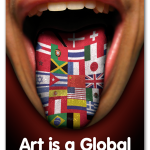
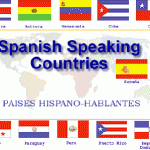

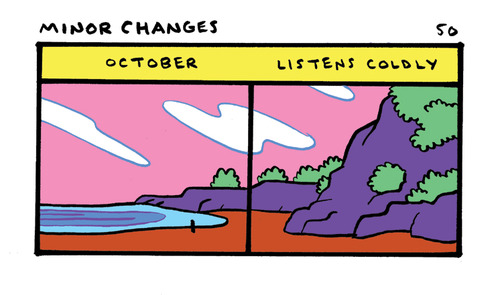
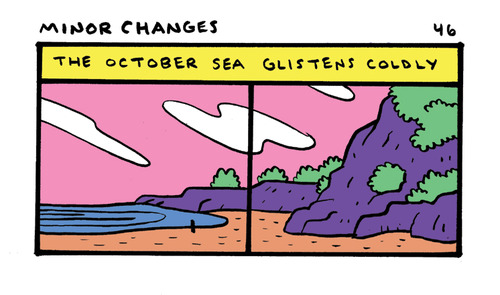
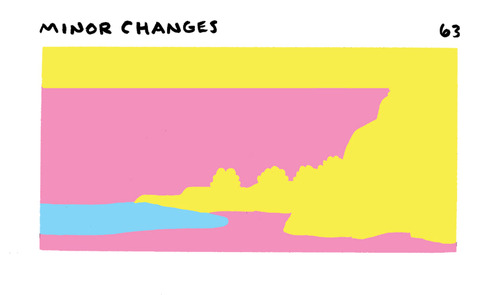
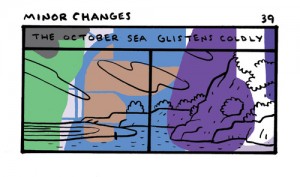
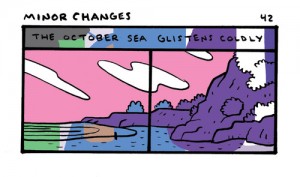
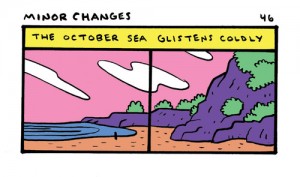
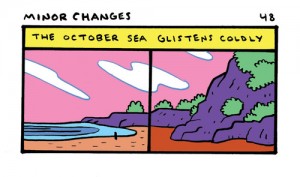

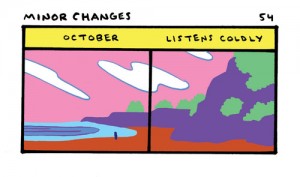
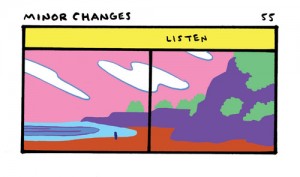
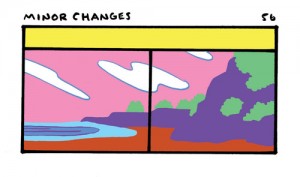
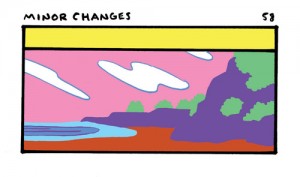
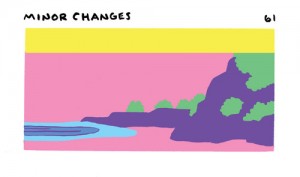
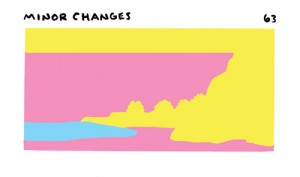
 D5 Creation
D5 Creation